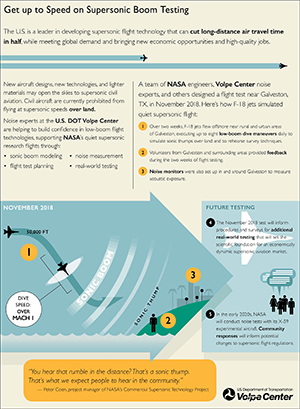Investigating Low-Boom Supersonic Air Travel
The U.S. is a leader in developing supersonic flight technology, and U.S. DOT Volpe Center noise experts are helping build confidence in low-boom flight technologies through sonic boom measurement, modeling, and minimization.
How supersonic civil flight may develop
Supersonic civil flight will likely first emerge with smaller aircraft, such as business jets. Public confidence in the low-boom technologies may lead to supersonic aircraft designs with larger passenger capacity.
Volpe Center noise experts are developing the science and gathering data to support regulatory processes and potential changes to FAA’s supersonic civil flight ban, which applies to overland flight only. Some companies are considering business models with supersonic flight over water.
Volpe experts are designing and testing low-boom supersonics for NASA
The Volpe Center is supporting National Aeronautics and Space Administration (NASA) Quiet Supersonic Flight 2018 (QSF18) tests by designing acoustic and subjective testing and analysis protocols for a demonstration vehicle that will gather data and inform international rulemaking.
Volpe assisted in designing the experiments and is now refining sonic boom modeling, flight procedures analysis, acoustic measurement techniques, and survey and community engagement protocols.
Testing low-boom supersonic flight near Galveston
Volpe helped NASA, Applied Physical Sciences, and industry partners design and conduct a QSF18 flight test near Galveston, Texas, in November 2018. This test used NASA F-18 jets to simulate quiet supersonic flights by creating sonic thumps over Galveston. Residents there were recruited to provide feedback on sound from the jets.
The test helped refine testing protocols and gather sample data. The QSF18 test will inform future assessments with NASA X-59 aircraft over different regions in the U.S., and in developing a human response database that the FAA and the International Civil Aviation Organization (ICAO) can use to evaluate potential changes to international supersonic flight regulations.
Gaining a better understanding of reactions to sonic thumps
This testing is a precursor to a national effort to understand how people react to the sound of quiet supersonic aircraft flying overhead. These tests will help inform the best ways to engage communities, collect acoustic data, and conduct surveys in response to sounds that people do not normally hear. The results will also inform ongoing ICAO activities supporting the reintroduction of commercial supersonic flight.
Aviation noise expert Juliet Page is leading low-boom supersonic testing at the Volpe Center.
The U.S. DOT Volpe Center is performing this work on behalf of NASA.

